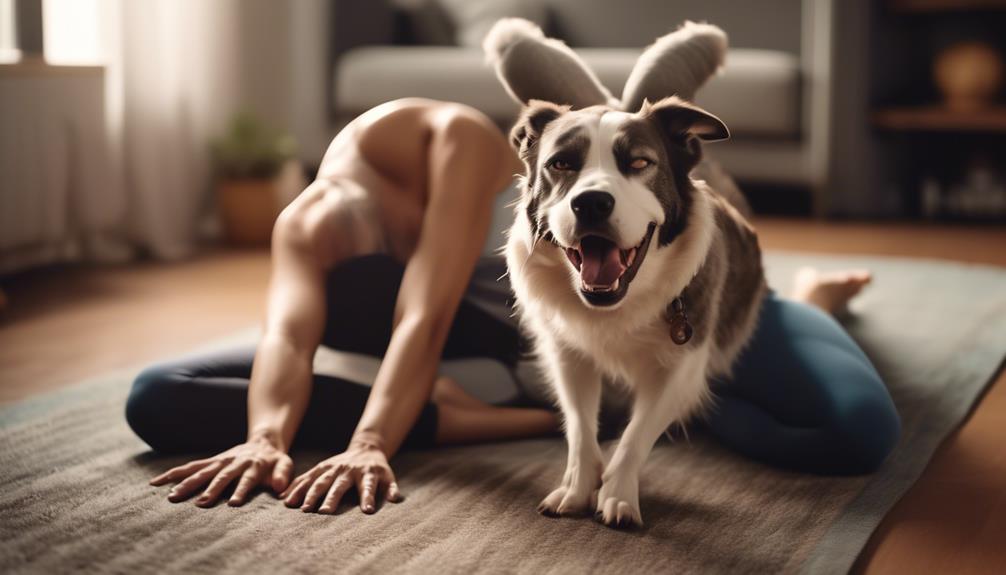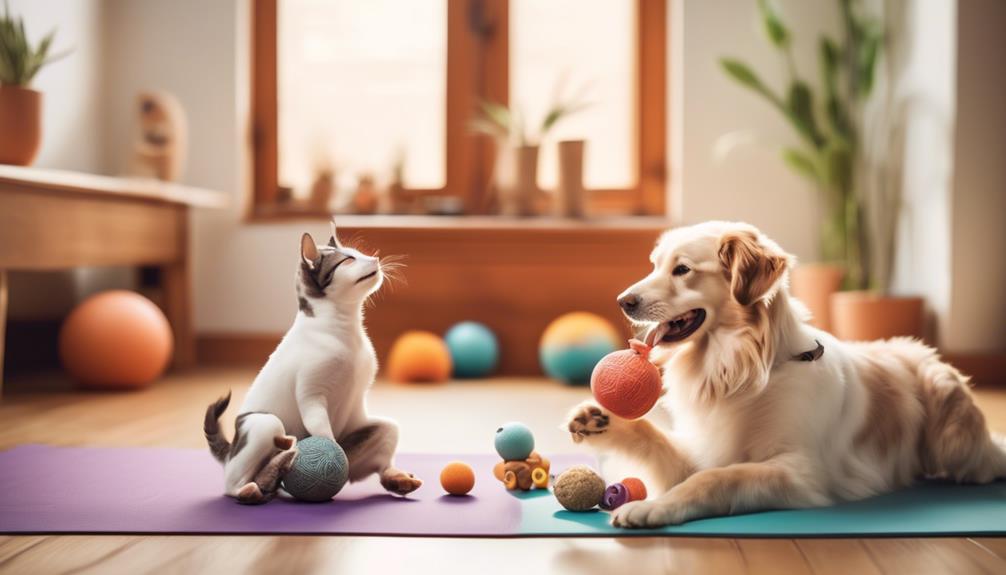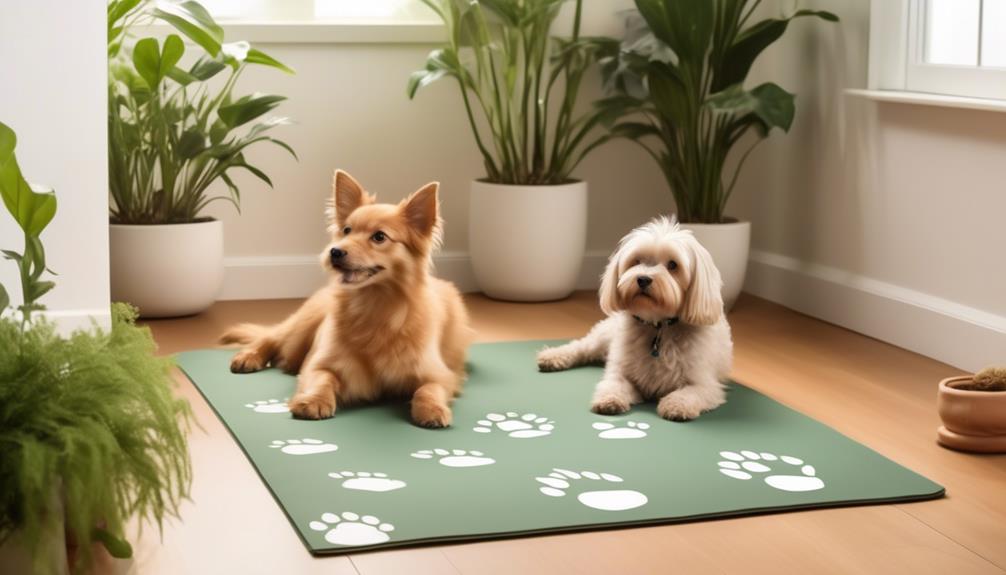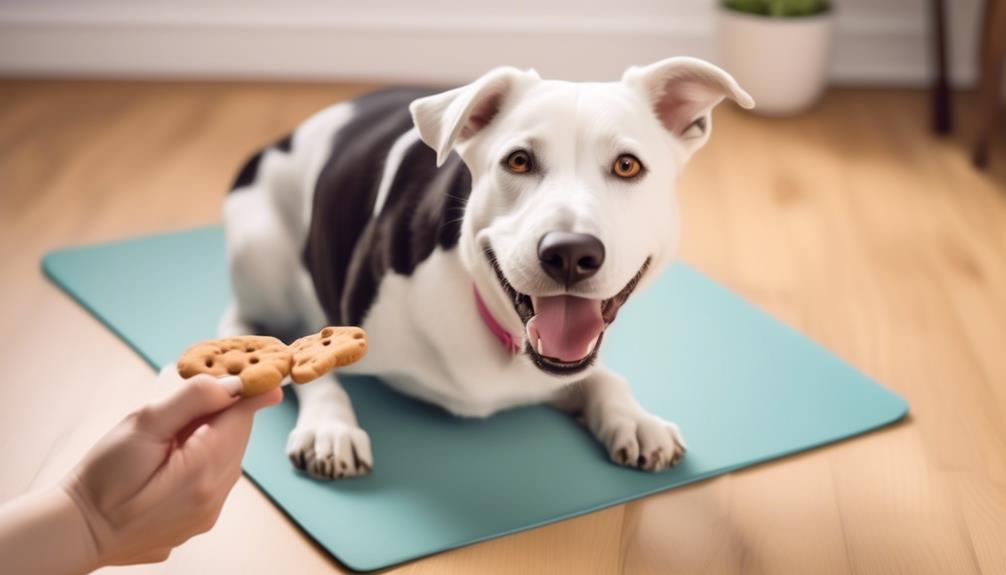What to Do if Your Pet Is Not Interested in Yoga

To get your pet interested in yoga, try incorporating their favorite toys or treats into the practice. Make it a fun and rewarding experience for them.
Key Takeaways
- Observe your pet's behavior and preferences to understand what activities they enjoy and what may cause anxiety or agitation.
- Start with short and simple exercises, gradually increasing the duration as your pet becomes more comfortable.
- Incorporate familiar toys or treats to make yoga sessions more engaging and rewarding for your pet.
- Create a designated pet-friendly yoga space that is inviting and comfortable, ensuring your pet feels included and not left out during practice.
Understand Your Pet's Preferences
Understanding your pet's preferences is crucial for creating a harmonious environment and deepening your bond with them. Just like humans, pets have their own unique personalities and individual needs. By taking the time to understand what your pet likes and dislikes, you can ensure that they're happy and content in their daily lives.
To understand your pet's needs, it's important to observe their behavior and pay attention to their reactions to different stimuli. For example, if your dog becomes anxious or agitated in crowded places, it may be a sign that they prefer quieter environments. On the other hand, if your cat loves to climb and explore high spaces, providing them with a tall scratching post or a cat tree can satisfy their natural instincts.
However, it's not just about identifying their preferences. It's also about finding alternative activities that align with their interests. If your pet doesn't enjoy yoga, for example, you can explore other forms of exercise or play that they might find more enjoyable. This could include activities like going for a walk, playing fetch, or engaging in interactive games with them.
Start With Short and Simple Exercises

To ensure a successful start to incorporating yoga into your pet's routine, it's important to begin with short and simple exercises that cater to their individual needs and preferences. By starting with exercises that are easy for your pet to follow, you can gradually progress to more challenging routines as they become more comfortable and familiar with the practice.
Here are three key tips to help you start with short and simple exercises:
- Begin with basic stretches: Start by introducing your pet to simple stretches that mimic their natural movements. For example, you can gently stretch their legs by extending them forward and holding for a few seconds. These simple exercises will help your pet become accustomed to the idea of yoga and build trust in the process.
- Incorporate relaxation techniques: Along with stretches, include calming techniques such as deep breathing exercises. Encourage your pet to take slow, deep breaths while gently massaging their back or belly. This won't only help them relax but also create a positive association with yoga.
- Keep sessions short and enjoyable: In the beginning, limit your yoga sessions to just a few minutes to prevent your pet from feeling overwhelmed. Make sure to keep the atmosphere relaxed and enjoyable, using treats or toys as rewards to motivate them. Gradually increase the duration of the sessions as your pet becomes more comfortable and engaged.
Incorporate Familiar Toys or Treats

Incorporating familiar toys or treats can enhance your pet's yoga experience and make it more enjoyable for them. Just like humans, pets can get bored or lose interest in activities that they find repetitive or unfamiliar. By incorporating their favorite toys or treats into their yoga routine, you can keep them engaged and motivated.
When selecting toys or treats, make sure they're pet-friendly and safe for them to use. Choose toys that are interactive and encourage movement, such as puzzle toys or treat-dispensing balls. These toys won't only keep your pet entertained but also provide mental stimulation and physical exercise.
Another way to incorporate familiar toys or treats is by using them as rewards during yoga sessions. For example, you can give your pet a treat after they successfully complete a yoga pose or series of exercises. This positive reinforcement will help them associate yoga with something enjoyable and rewarding.
In addition to toys and treats, you can also introduce alternative exercises that your pet enjoys. For instance, if your pet loves playing fetch, incorporate a game of fetch into their yoga routine. This will allow them to engage in physical activity while still participating in pet-friendly activities.
Create a Designated Pet-Friendly Yoga Space

To create a welcoming environment for your pet's yoga practice, it's important to establish a designated space that's specifically designed to accommodate their needs. Here are three key tips to help you create a pet-friendly yoga space:
1) Use pet-friendly accessories: Incorporating pet-friendly accessories into the yoga space can make it more inviting for your furry friend. Consider using a cozy pet bed or blanket where they can relax while you practice. Additionally, placing their favorite toys nearby can help keep them engaged and entertained.
2) Provide alternative exercise options: While yoga may not be your pet's cup of tea, providing alternative exercise options can keep them active and involved. Set up a small agility course or play area within the designated space where they can engage in their own physical activities while you practice yoga. This way, they can still be part of the experience without feeling left out.
3) Create a calming atmosphere: Pets thrive in a calm and peaceful environment. To create a serene atmosphere in the yoga space, consider playing soothing music or using aromatherapy diffusers with scents that are safe for pets. This can help create a relaxing ambiance that encourages your pet to feel comfortable and at ease in the space.
Use Positive Reinforcement Techniques

Positive reinforcement techniques are essential when practicing yoga with pets. Reward-based training methods, such as using treats or verbal praise, can help motivate pets to participate in the yoga session.
Incorporating play into the practice can also make it more enjoyable for both the pet and the owner. By using positive reinforcement techniques, owners can create a positive and rewarding experience for their pets during yoga sessions.
Reward-Based Training Methods
Using reward-based training methods is a practical and effective approach to teaching pets new behaviors and reinforcing positive habits. This technique focuses on providing rewards, such as treats or praise, to encourage desired behaviors and discourage unwanted ones. Here are three key benefits of using reward-based training:
- Enhanced Learning: Positive reinforcement techniques help pets associate good behavior with positive outcomes, making it easier for them to understand what's expected of them.
- Stronger Bond: By using rewards, you create a positive and enjoyable experience for your pet during training sessions. This helps strengthen the bond between you and your furry friend, building trust and cooperation.
- Long-lasting Results: Reward-based training creates lasting behavioral changes because pets are motivated to repeat actions that result in rewards. This approach promotes a positive mindset and encourages pets to make good choices even when not directly prompted.
Motivating With Treats
Motivating pets with treats is a highly effective technique for utilizing positive reinforcement methods in training. By rewarding desired behaviors with tasty treats, pet owners can encourage their furry friends to engage in activities such as yoga. However, it is important to remember that treats should be used in moderation to maintain a balanced diet for the pet.
In addition to treats, motivating with praise is another powerful tool to reinforce positive behavior. Verbal affirmations and enthusiastic encouragement can go a long way in boosting your pet's confidence and willingness to participate in yoga sessions.
Moreover, using interactive toys can make the training process more enjoyable for both pet and owner. Toys that require physical activity and mental stimulation can keep your pet engaged and motivated during yoga sessions.
To better understand the effectiveness of motivating with treats, here is a table that outlines the benefits and considerations of this technique:
| Benefits | Considerations |
|---|---|
| Reinforces positive behavior | Can lead to weight gain if not balanced with exercise |
| Enhances pet's motivation | Over-reliance on treats may diminish other forms of reinforcement |
| Builds a strong bond between pet and owner | Treats should be used sparingly to maintain their value |
Incorporating Play Into Yoga
After establishing a strong foundation of positive reinforcement techniques, pet owners can now explore the exciting realm of incorporating play into their pet's yoga practice. By incorporating playful poses and interactive yoga, owners can make the yoga experience more enjoyable for their pets.
Here are three ways to incorporate play into your pet's yoga routine:
- Introduce toys: Place your pet's favorite toys strategically around the yoga space. Encourage them to engage with the toys during the practice, incorporating playful movements and stretches.
- Incorporate games: Use interactive games, such as hide-and-seek or fetch, to add a playful element to the yoga session. This won't only keep your pet engaged but also enhance their overall experience.
- Reward with playtime: After completing a yoga session, reward your pet with a dedicated playtime. This will reinforce the positive association between play and yoga, making them more likely to participate willingly in future sessions.
Seek Professional Guidance or Join a Pet-Friendly Yoga Class

When it comes to practicing yoga with your pet, seeking professional guidance can make a world of difference. Certified pet trainers can provide valuable advice on how to create a safe and calming environment for your furry friend during yoga sessions.
Additionally, finding experienced yoga instructors who've worked with pets before can ensure that both you and your pet are comfortable and supported in your practice.
Exploring pet-friendly studios can also be a great option, as these spaces are specifically designed to accommodate pets and their owners, creating a welcoming and inclusive environment for everyone involved.
Consult Certified Pet Trainers
To ensure a safe and enjoyable experience for both you and your pet, it's highly recommended to consult with certified pet trainers for professional guidance or consider joining a pet-friendly yoga class. These experts have the knowledge and experience to help you understand your pet's behavior and find solutions to any challenges that may arise during your yoga sessions.
Here are three reasons why consulting with certified pet trainers is beneficial:
- Expert advice: Certified pet trainers can offer valuable insights into your pet's behavior and help you address any issues that may be hindering their participation in yoga. They can provide personalized guidance tailored to your pet's specific needs, ensuring a positive and productive experience.
- Training techniques: Trainers can teach you effective techniques to engage your pet in yoga, such as using positive reinforcement and rewards. They can provide step-by-step instructions on how to introduce yoga to your pet and gradually increase their comfort level.
- Behavioral modification: If your pet is resistant to yoga, a certified trainer can assist in identifying any underlying behavioral issues that may be causing the reluctance. They can offer strategies to modify these behaviors and create a more conducive environment for pet yoga.
Find Experienced Yoga Instructors
Continuing your journey towards pet-friendly yoga, it's important to find experienced yoga instructors who can provide professional guidance or lead pet-friendly yoga classes. These instructors have the knowledge and expertise to create a safe and comfortable environment for both you and your pet.
They understand that each pet is unique and may have different preferences when it comes to participating in yoga. An experienced instructor will take the time to assess your pet's temperament, energy levels, and specific needs, ensuring that the yoga practice is tailored to suit them.
They'll also be able to offer modifications and adjustments to accommodate any physical limitations or restrictions your pet may have.
Explore Pet-Friendly Studios
To fully immerse yourself in the world of pet-friendly yoga, consider seeking professional guidance or joining a pet-friendly yoga class at a local studio. Here are three reasons why exploring pet-friendly studios can enhance your yoga experience:
- Access to pet-friendly equipment: Pet-friendly studios provide specialized equipment designed to accommodate both you and your furry friend. From yoga mats with built-in pet beds to adjustable straps for pet-assisted poses, these studios ensure the comfort and safety of both you and your pet.
- Expert guidance: In pet-friendly yoga classes, experienced instructors guide you through modified poses and alternative exercises that incorporate your pet. They understand the unique challenges and benefits of practicing yoga with animals and can offer personalized advice to help you and your pet achieve a harmonious practice.
- Community support: Joining a pet-friendly yoga class allows you to connect with like-minded individuals who share your love for animals and yoga. It creates a supportive and inclusive environment where you can bond with fellow pet owners and learn from their experiences.
Be Patient and Adjust Your Expectations

Adjusting your expectations and practicing patience is crucial when incorporating pets into your yoga routine. It's important to understand that not all pets will be interested in participating in yoga, and that's perfectly okay. Just like humans, animals have their own preferences and personalities. Some may be more active and curious, while others may be more laid-back and independent.
When introducing your pet to yoga, it's essential to be patient and understanding. Don't force them to participate if they show no interest or seem uncomfortable. Instead, observe their behavior and body language to gauge their level of comfort. If they prefer to watch you from a distance, let them be. If they decide to join you on the mat, allow them to explore and find their own spot.
Adjusting your expectations is also key. While you may envision a perfect yoga session with your beloved pet by your side, it's essential to remember that their participation may be sporadic or fleeting. They may only join you for a few minutes before wandering off, and that's completely normal.
Ultimately, the goal is to create a harmonious environment where both you and your pet can enjoy the benefits of yoga. By being patient, understanding your pet's preferences, and adjusting your expectations, you can find a balance that works for both of you. Remember, every pet is unique, and their individuality should be respected and celebrated.
Frequently Asked Questions
Can I Force My Pet to Do Yoga Even if They Are Not Interested?
Forcing pets to do yoga, even if they are not interested, is not recommended. It's important to respect their choices and well-being. Instead, focus on understanding the benefits of pet yoga and finding other ways to bond with your pet.
What Are the Potential Risks or Dangers of Forcing My Pet to Participate in Yoga?
Forcing pets into yoga can pose potential risks and dangers. It may negatively impact their well-being, causing stress or injury. It's important to respect their disinterest and find alternative activities that align with their natural instincts and preferences.
How Long Does It Usually Take for a Pet to Become Interested in Yoga?
Introducing yoga to a pet can be a gradual process. Signs that your pet may be ready include showing curiosity, being relaxed during stretching exercises, and willingly participating. It's important to be patient and let them set the pace.
Are There Any Specific Yoga Poses That Are More Appealing to Pets?
Pet friendly yoga poses can include gentle stretches and movements that mimic natural animal behaviors. Some pets may enjoy poses like downward dog or cat-cow. Alternatives to yoga for pets can include interactive play or agility exercises to provide similar benefits.
Can I Use Punishment or Negative Reinforcement to Encourage My Pet to Do Yoga?
Using negative reinforcement in pet training is not recommended as it can harm the bond between you and your furry friend. Instead, focus on making yoga more enjoyable for pets by incorporating play, treats, and positive reinforcement.









